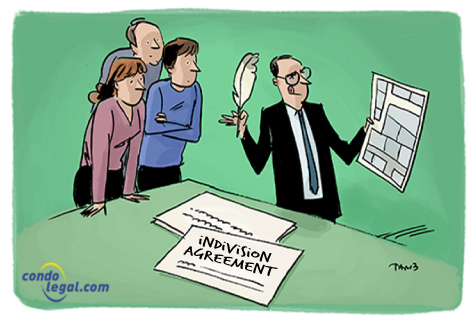
Undivided co-ownership has existed since time immemorial, even before the existence of divided co-ownership. Joint ownership allows two or more people to own a building while sharing the acquisition and operating costs. A co-ownership is said to be undivided when the right of ownership is not accompanied by a physical division of the property. The building usually has only one lot number. The owners own a share of this lot. Municipal and school tax bills are therefore intended for all the co-owners of the building, who must separate the costs. In addition, since 1994, the Civil Code of Québec has included several rules governing joint ownership.
Alternative to divided co-ownership
The conversion of a immovable to divided co-ownership (condos) is subject to strict formalities and municipal by-laws, which can restrict the conversion or make it subject to certain conditions.. Unfortunately this does not always prove possible, more particularly because of the very high costs such a process implies (such as subdivision taxes known «Parkland taxes» applicable in certain boroughs of Montreal or other municipalities) and vested rights in favor of tenants.
An interesting alternative is then offered to undivided co-owners, namely the subjugation of the building to undivided co-ownership agreement, at a lower cost and without many formalities. You should know, however, that the characteristics of an apartment owned in divided or undivided co-ownership are quite different (consult the factsheet: Divided and undivided co-ownership.).
The undivided co-ownership agreement
Undivided co-ownership can be done with or without an agreement between owners. However, the current market shows that the existence of an indivision agreement containing the required clauses for the protection of co-owners and hypothecary creditors brings an added value, compared to undivided co-ownership, which is also reflected in the sale price of its share and the valuation used to obtain the separate mortgage financing for each of the co-owners. In some neighbourhoods, this added value is even equal to that brought by the conversion into divided co-ownership.
The so-called organized co-ownership agreement specifies the rules that govern the undivided co- owners and includes provisions for the protection of the undivided co-owners and their creditors. It is imperative that it be prepared by a notary whose expertise is recognized in this field. Unlike a declaration of co-ownership, an undivided co-ownership agreement cannot be signed by a single owner. Indivision necessarily implies the presence of at least two co-owners. If a developer wants to sell under the undivided co-ownership formula, he will have to wait for the purchase of a first unit by a purchaser, after which the undivided co- ownership agreement may be signed and registered in the land register.
The undivided co-ownership agreement provides for the exclusive rights of use of each co- owner, for example regarding the use of the courtyard, balconies, roof terraces and parkings. Also, a well drafted agreement will contain the special cross hypothec allowing a recourse against the share in the immovable of a defaulting co-owner.
Nowadays, indivision agreements are much more extensive. In fact, their content can be similar to that of a declaration of co-ownership, for example with regard to common charges and rules concerning meetings of co-owners. However, they can be distinguished. For example, interest holders could decide to grant an interest holder a veto over certain decisions, require unanimity for others, or establish majorities that are not necessarily equal to the shares of each interest holder. The distribution of common expenses may also be done in other ways than in proportion to the shares of each party.
Cadastral operations
In undivided co-ownership, cadastral operations are not required, since the co- owners hold undivided rights in the same property. The certificate of location is not different from that of the non-converted building. However, it is possible to ask a land-surveyor to draw the plans and take measurements of the various apartments and common portions for restricted use, where appropriate, to obtain a certificate of location that better represents the reality of the various uses of the immovable.
Hypothecs
Contrary to popular belief, the existence of a so called organized undivided co-ownership agreement will allow co- owners to hypothec their share in the immovable and the exclusive rights of use of their apartments, independently of other co- owners, so they will not be held responsible in the event of the default of a co- owner on his hypothec. These hypothecs are usually granted by the National Bank or Caisses Desjardins. The minimal down payment required is 20% of the condo purchase price, not 5%, as is the case in most divided co‑ownerships.
Some disadvantages
The Civil Code of Quebec allows a landlord to repossess a dwelling to live in it himself or to house certain members of his immediate family. However, it is important to know that in a situation of joint ownership with a person other than his or her spouse, it is not possible for an owner to repossess a residential dwelling since a restriction to this effect has been provided for in the Civil Code.
The co-owners are held jointly and severally liable for certain costs and charges such as municipal and school taxes, insurance, maintenance and repair costs of the common portions. In addition, it is important that the agreement include a clause requiring the co-owner who wants to do major work on his or her apartment to provide the others with sufficient guarantees that he or she has sufficient funds to pay for the work. In these respects, a portion of the equity (20% down payment) on each of the shares will be used to ensure compliance with the obligations of the interest holders under the agreement through the intersecting mortgage created in favour of each of the interest holders and contained in the joint ownership agreement.
Conclusion
In summary, although organized undivided co-ownership may have some disadvantages, it can often be an interesting alternative to conversion into divided co-ownership. A consultation with a notary specialized in the field of co‑ownership could help you make an informed choice in this regard.
 WHAT YOU SHOULD KNOW! The Civil code of Québec, allows each undivided co-owner to obtain a separate hypothec binding only himself. In the present market, save for particular cases, only the National Bank of Canada and some Desjardins credit unions grant this type of financing, and even then only if an indivision agreement is registered on the immovable.
WHAT YOU SHOULD KNOW! The Civil code of Québec, allows each undivided co-owner to obtain a separate hypothec binding only himself. In the present market, save for particular cases, only the National Bank of Canada and some Desjardins credit unions grant this type of financing, and even then only if an indivision agreement is registered on the immovable.
 WHAT TO KEEP IN MIND: The Civil code of Québec does not regulate to any extent the rights and obligations of undivided co-owners. Without an indivision agreement, none of you can claim having an exclusive right of occupation of a portion of the immovable in particular. To insure the drafting of an indivision agreement in which the rights, obligations and guaranties are clearly spelled out, it is important to consult a notary with experience in these matters.
WHAT TO KEEP IN MIND: The Civil code of Québec does not regulate to any extent the rights and obligations of undivided co-owners. Without an indivision agreement, none of you can claim having an exclusive right of occupation of a portion of the immovable in particular. To insure the drafting of an indivision agreement in which the rights, obligations and guaranties are clearly spelled out, it is important to consult a notary with experience in these matters.
 WARNING! It is important to note that most indivision agreements do not allow rentals. In addition, they must be published in the Quebec Land Register so that they can be enforceable against third parties.
WARNING! It is important to note that most indivision agreements do not allow rentals. In addition, they must be published in the Quebec Land Register so that they can be enforceable against third parties.


